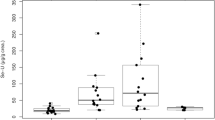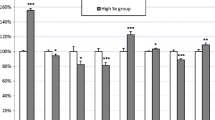Abstract
Purpose
The aim of the study was to assess external and internal selenium exposure and potential biological effects in employees working in a selenium-processing plant.
Methods
Twenty male employees of a selenium-processing plant (exposed) and 20 age-matched male individuals without occupational selenium exposure (controls) participated in the study. Exposure to selenium at the workplace was determined by personal air sampling. Internal exposure was assessed by measuring total selenium concentration in plasma after a workshift and after holidays as well as by measuring the selenium concentration in urine before and after shift and after holidays. The activity of glutathione peroxidase (GPx) in blood and the prothrombin time were determined as biological effect parameters.
Results
The exposure to selenium in the workplace air ranged from 8 to 950 µg/m3 and exceeded in a large part current occupational exposure limits. The selenium levels in plasma samples of the exposed ranged from 49 to 182 µg/L during exposure and were significantly higher than the plasma levels observed after holidays as well as in the control group. The selenium concentration in pre- and post-shift urine samples did not differ significantly, and the average urinary selenium levels of the employees (18–1,104 µg/g creatinine) were significantly higher than those measured after holidays or determined in controls. Both the concentration of selenium in plasma and in urine did not correlate with the current external exposure of the employees at the workplace. However, we found a strong and significant association between the two biomonitoring parameters. In spite of the considerable high external exposure to elemental selenium, we did not find any effect on the GPx activity in blood as well as on the prothrombin time.
Conclusions
Both the selenium levels in plasma and urine may be used as biological monitoring parameters for the assessment of chronic occupational exposure to selenium. Nevertheless, the toxicokinetics of the urinary excretion of selenium remain still unclear and require further investigations. Moreover, our findings emphasise the necessity of a re-evaluation of occupational exposure limits for elemental selenium and inorganic selenium compounds.


Similar content being viewed by others
References
ACGIH – American Conference of Governmental Industrial Hygienists (2013) TLVs and BEIs based on the documentation of the threshold limit values for chemical substances and physical agents & biological exposure indices. ACGIH, Cincinnati
Alfthan G, Aro A, Arvilommi H, Huttunen JK (1991) Selenium metabolism and platelet glutathione peroxidase activity in healthy Finnish men: effects of selenium yeast, selenite, and selenate. Am J Clin Nutr 53:120–125
Ashton K, Hooper L, Harvey LJ, Hurst R, Casgrain A, Fairweather-Tait SJ (2009) Methods of assessment of selenium status in humans: a systematic review. Am J Clin Nutr 89:2025S–2039S
Diskin CJ, Tomasso CL, Alper JC, Glaser MK, Fliegel SE (1979) Long-term selenium exposure. Arch Intern Med 139:824–826
DFG - Deutsche Forschungsgemeinschaft (2014) List of MAK and BAT values 2014. Commission on the Investigation of Health Hazards of Substances in the Work Area. Report No. 50. Wiley-VCH, Weinheim. doi:10.1002/9783527682010.oth2
Glover JR (1967) Selenium in human urine: a tentative maximum allowable concentration for industrial and rural population. Ann Occup Hyg 10:3–14
Glover JR (1970) Selenium and its industrial toxicology. Ind Med 39:50–54
Gundacker C, Komarnicki G, Zödl B, Forster C, Schuster E, Wittmann K (2006) Whole blood mercury and selenium concentrations in a selected Austrian population: Does gender matter? Sci Total Environ 372:76–86. doi:10.1016/j.scitotenv.2006.08.006
Heitland P, Michalke B, Working group ‘Analyses in Biological Materials’ (2013) Selenium in serum. In: Göen T, Hartwig A (eds) The MAK collection in occupational health and safety. Part IV: biological methods, vol 13. Wiley-VCH, Weinheim, pp 249–263. doi:10.1002/3527600418.bi778249e0013
Hoeflich J, Hollenbach B, Behrends T, Hoeg A, Stosnach H, Schomburg L (2010) The choice of biomarkers determines the selenium status in young German vegans and vegetarians. Br J Nutr 104:1601–1604
Jäger T, Drexler H, Göen T (2013) Ion pairing and ion exchange chromatography coupled to ICP-MS to determine selenium species in human urine. J Anal At Spectrom 28:1402–1409. doi:10.1039/c3ja50083g
Jäger T, Drexler H, Göen T (2014) Human metabolism and renal excretion of selenium compounds after oral ingestion of sodium selenate dependent on trimethylselenium ion (TMSe) status. Arch Toxicol. doi:10.1007/s00204-014-1380-x
JSOH – The Japan Society for Occupational Health (2013) Recommendation of occupational exposure limits. J Occup Health 55:422–441
Navarro-Alarcon M, Cabrera-Vique C (2008) Selenium in food and the human body: a review. Sci Total Environ 400:115–141. doi:10.1016/j.scitotenv.2008.06.024
Parshukova O, Potolitsyna N, Shadrina V, Chernykh A, Bojko E (2014) Features of selenium metabolism in humans living under the conditions of North European Russia. Int Arch Occup Environ Health 87:607–614
Stranges S, Marshall JR, Natarajan R, Donahue RP, Trevisan M, Combs GF, Cappuccio FP, Ceriello A, Reid ME (2007) Effects of long-term selenium supplementation on the incidence of type 2 diabetes: a randomized trial. Ann Intern Med 147:217–223
Thomson CD, Robinson MF, Butler JA, Whanger PD (1993) Long-term supplementation with selenite and selenomethionine: selenium and glutathione peroxidase in blood components of New Zealand women. Br J Nutr 69:577–588
Vinceti M, Wei ET, Malagoli C, Bergomi M, Vivoli G (2001) Adverse health effects of selenium in humans. Rev Environ Health 16:233–251
Wolters M, Hermann S, Golf S, Katz N, Hahn A (2006) Selenium and antioxidant vitamin status of elderly German women. Eur J Clin Nutr 60:85–91. doi:10.1038/sj.ejcn.1602271
Yang G, Yin S, Zhou R, Gu L, Yan B, Lin Y, Liu Y (1989) Studies of safe maximum daily dietary Se-intake in a seleniferous area in China. Part II: relation between Se-intake and the manifestation of clinical signs and certain biochemical alterations in blood and urine. J Trace Elem Electrolytes Health Dis 3:123–130
Acknowledgments
The study was supported by the Franz-Koelsch Foundation for the Promotion of Occupational Medicine (Erlangen) and by the Federation of Supporters of the University of Erlangen-Nuremberg (Unibund). The authors are grateful to all employees who participated in the study and the management of the plant. The authors are indebted to Johannes Müller who performed the air sampling, Barbara Verhoeven for her technical assistance and Michaela Förster for proofreading.
Conflict of interest
The authors declare no conflict of interest.
Author information
Authors and Affiliations
Corresponding author
Rights and permissions
About this article
Cite this article
Göen, T., Schaller, B., Jäger, T. et al. Biological monitoring of exposure and effects in workers employed in a selenium-processing plant. Int Arch Occup Environ Health 88, 623–630 (2015). https://doi.org/10.1007/s00420-014-0989-7
Received:
Accepted:
Published:
Issue Date:
DOI: https://doi.org/10.1007/s00420-014-0989-7




